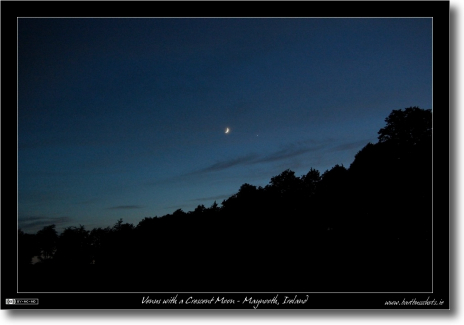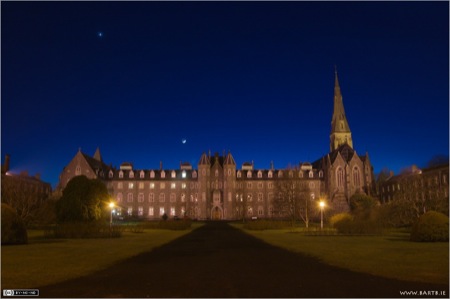Jan
12
Photo of the Week 152 – Moon & Venus Over SPCM
Filed Under Photography on January 12, 2011 | Leave a Comment
I was looking back through some older shots this week when I noticed this one which I had forgotten to upload to Flickr. I have no idea why I didn’t upload it when I shot it, because it’s one of my best astrophotography shots, nicely and clearly incorporating both the Moon and the Planet Venus into the shot. What at we see here is a view across St. Joseph’s Square in St. Patrick’s College Maynooth (SPCM)looking towards St. Patrick’s House with the spire of the College Chapel also visible. In the top left of the shot you can see Venus, and just above the building you can see a very thin crescent Moon with a lot of Earth Shine. This shot was taken with a tripod because it was dark and a four and half second exposure was needed.
- Camera: Nikon D40
- Lens: Nikon DX AFS 18-55mm (D40 kit lens)
- Exposure: 4.5 sec (shot on tripod)
- Focal Length: 19mm
- Focal Ratio: f/8
- ISO: 200
- Camera Mode: Aperture Priority
- Exposure Bias: -3.0ev
Mar
15
Photo of the Week 4 – Venus with a Crescent Moon
Filed Under Photography on March 15, 2008 | 1 Comment
This photo was taken on the evening of the 18th of June 2007 on the playing fields on the South Campus of NUI Maynooth. The playing fields are large open grass areas for sport surrounded by wonderful old trees. This photo was taken just as twilight was ending when the Moon and Venus were very close together in the sky.

Click to View Full-Size (1.6MB)
For those of you interested in such things here are some of the technical details of the shot:
- Camera: Nikon D40
- Lens: Nikon DX AFS 18-55mm (D40 kit lens)
- Exposure: 1/30 Sec
- Focal Length: 34mm
- Focal Ratio: F5.6
- ISO: 1600
- Camera Mode: Aperture Priority
- Exposure Compensation: -1
[tags]Ireland, Maynooth, NUI Maynooth, Venus, Moon[/tags]
May
20
A Good Night for Observing Planets
Filed Under Science & Astronomy on May 20, 2007 | Leave a Comment
Having set myself the challenge of observing all the planets with a pair of 10x50mm binoculars I bought in Lidle for €19 this year I got to tick another one off my list today, Jupiter. I now just need Mars and the two difficult ones, Uranus & Neptune. Although Jupiter is the only one I get to cross off my list today I did get to observe many more planets, in fact, I observed all the planets bar the three I’m missing!
Feb
4
Bart’s Planet Challenge 2007 – The Beginning
Filed Under Science & Astronomy on February 4, 2007 | 3 Comments
One of the things that occoured to me when Pluto got re-classified was that it is now possible to see all the planets in our solar system with nothing more expensive than a 19 Euro pair of binoculars from Lidel. So, this year my challenge to myself is to do just that, observe all the planets with nothing more than my 10×50 binoculars. Venus, Mars, Jupiter and Saturn will be very easy, the others will be more tricy. Mercury, because it spends so much time so close to the Sun that you are dependent on a clear western horision some time you can actually get out to see it within a few short windows each year, and Uranus and Neptune because they’ll require the binoculars to see. If you’re a beginner this is a very good challenge to help you get to know the sky and to become adept with your binoculars and/or telescope. I’d strongly advice you give this a go.
Oct
11
Uranus and Neptune Observed
Filed Under Science & Astronomy on October 11, 2006 | Leave a Comment
I’m just in from a very productive observing session. Tonight was the first time in a long time that I’ve been in the country side (at my parent’s place in Cavan) on a clear moon-free night. I’ve just come in now because the moon is starting to rise but before the sky started to brighten too much I was able to get some good observing in. I had set myself the challenge of finding Uranus since I said it would be easy on the IFAS Podcast and then, if I had time, I was going to try to find Neptune as well.
[tags]Uranus, Neptune[/tags]
Mar
1
A Small But Dedicated Crew of Observers
Filed Under 42 (Life the Universe & Everything) on March 1, 2006 | Leave a Comment
Yesterday was a bitterly cold day and last night was no warmer. After the excellent Astro2 talk on Science, Religion and Dawkins only three of us were brave enough to venture out into the cold for some observing but for those of us that did it was well worth it. We had stunning views of Saturn showing the cloud bands and the Cassini division very clearly, amazing views of the Orion Nebula at ridiculously low magnification (30X) so as to get th entire thing into the same field of view and then we zoomed in on the core for a closer look. We also took in some of the open clusters in Auriga and M35 in Gemini as well as a rather un-impressive M1 (light pollution really spoils it). We then finished off with another look at Saturn because none of us could get enough of that beauty!
Feb
8
An Unexpected Observing Session
Filed Under 42 (Life the Universe & Everything) on February 8, 2006 | Leave a Comment
We had an unexpected observing session at the Astro2 meeting today. As we went in to the excellent talk on Gravitational waves it was pelting with rain but when we came out later the sky had completely cleared and there wasn’t a cloud in sight so we all trudged up to the physics department observatory for a wonderful observing session.
We started out with a look at Saturn, first at 100X and then at 190X. The air was not very stable so close after a major weather system had passed by so although Saturn looked very crisp (and big) at 100X even 190X was starting to push the limits a bit. At 190X we could clearly see the cloud bands on Saturn, the shadow of the rings and in moments of good seeing the Cassini Division in the rings. Saturn looked a little nicer than usual today because the background was just peppered with loads of stars from the large open cluster M44 (the Beehive Cluster) which Saturn is currently moving through.
After Saturn we turned our attention to The Orion Nebula (M42). Because the over half full moon was very close to Orion I decided to go for as low a magnification as possible to give maximum stability, contrast and sharpness to our view. Even with the moon interfering the nebula still looked stunning at 62X with the LX200. The contrast was excellent and all four stars of the trapezium were easily separable. There was also a lot of detail visible in the nebula. All in all people seemed impressed with the view since there were lots of oooh’s and aaaah’s as people were looking.
Finally, after everyone had had a good look at M42 we moved on to the moon. We started at 62X so that people could see the whole disk at once and also get an idea of the scale of the Orion Nebula which they had just seen at the same magnification. We ended the session by allowing everyone a ‘moon walk’, i.e. I put in our highest eyepiece (6.4mm giving a magnification of 390X) and gave each person observing the key pad and let them scan the moon for a while.
All in all it turned out to be a great observing session probably made all the more enjoyable by the fact that none of us had expected the opportunity for observation to present it self tonight!
Oct
14
Mars up-close
Filed Under 42 (Life the Universe & Everything) on October 14, 2005 | Leave a Comment
At the moment Mars is making it’s closest approach to Earth for the next 18 years so Astro2 thought this was too good a chance to miss! The only slight drawback was that Mars wasn’t well placed for observation from the Physics Observatory until after midnight. However, I offered to run a Mars watch at 1am and to my great surprise I wasn’t alone! There were in fact over 20 other people braving the cold with me!
This was the first opportunity Astro2 had to use the physics department’s LX200 10" telescope. The conditions were not really ideal but we did nonetheless get a good look. We started off with a 15mm eyepiece giving a magnification of about 170X which allowed people to see some surface details while keeping the magnification low enough to keep the image nice and sharp. Once everyone had a look at the low magnification I changed to a 12mm eyepiece to increase the magnification to about 120X. At this stage the sky was getting very hazy and there was a good coating of dew on the corrector plate of the telescope but we could still easily see the black regions on the surface even though the image was quite fuzzy. I did try to up the magnification to about 280X with a 9mm eyepiece but that just wasn’t gonna happen in those conditions!
All in all I think people had a good time and I’m really encouraged by such a high turnout for an Astro2 event at 1am!







